 |
 |
 |
| |
Hepatic profile of tipranavir in treatment experienced HIV-1 infected individuals
|
| |
| |
Reported by Jules Levin
11th EACS, Madrid, Spain, Oct 2007
Stanislas Pol1, Yves Benhamou2, Juergen Rockstroh3, Mark S Sulkowski4,
Douglas Dieterich5, Patrick Robinson6, Jaromir Mikl6, Jerry Stern6
1Hopital Cochin, APHP, Unite d'Hepatologie, Paris, France; 2Service d'Hepato-Gastroenterologie, Hopital Pitie-Salpetriere, Paris, France; 3Department of Medicine I, University of Bonn, Bonn, Germany; 4Division of Infectious Diseases, John Hopkins University School of Medicine, Baltimore, USA; 5Mount Sinai School of Medicine, New York, New York, USA; 6Boehringer Ingelheim Pharmaceuticals, Inc., Ridgefield, CT, USA
Author Conclusions
In TPV/r Phase IIb/III trials in highly treatment-experienced patients (n=1299), the majority of patients (88.9%) did not develop Grade 3 or 4 ALT/AST elevations through 96 weeks of treatment.
Most cases of Grade 3 or 4 transaminase elevations were asymptomatic (85%). The majority of patients (105/144; 72.9%) were able to continue and/or interrupt TPV/r without permanent discontinuation with subsequent decrease in transaminase elevation to Grade ≦2.
After developing Grade 3/4 ALT/AST levels, 93/144 patients (65%) continued TPV/r treatment. Of these, 88 (94.6%) experienced a return to Grade ≦2 ALT/AST levels in a median of 32 days (IQR=14-84 days) while taking TPV/r.
Among the 144 patients developing Grade 3/4 ALT/AST, only 21.7% (31/144) required discontinuation of therapy (20 patients with immediate discontinuations and 11 patients with interruptions followed by subsequent discontinuation).
Clinical hepatic SAEs were infrequent (1.1%) in the five TPV/r trials included in this analysis.
Asymptomatic laboratory Grade 3/4 ALT/AST elevations were a poor predictor of serious clinical hepatic events.
Abstract
Background Tipranavir (TPV/r) is effective in treatment-experienced patients with resistance to ≥1 PI. Elevations in serum transaminases are common in ARV-treated patients; some patients are at risk of severe hepatotoxicity. Chronic viral hepatitis co-infection may increase the risk of drug-induced hepatotoxicity. We evaluated serum transaminase elevations and hepatic serious adverse events (SAEs) among patients receiving 500/200 mg BID TPV/r in Phase IIb/III trials
through 96 weeks.
Methods Transaminase elevations and hepatic SAEs through 96 weeks were characterized, using pooled data from five TPV/r trials. Kaplan-Meier (K-M) probability estimates for time to first Grade 3/4 transaminase elevation, first clinical hepatic SAE, and clinical outcomes after Grade ≥3 transaminase elevations were analyzed.
Results: 1299 treatment-experienced patients took 500/200 mg BID TPV/r. 179 high-risk (HBV or HCV co-infection and/or baseline transaminases Grade >1); 1088 were low-risk; and 32 unclassified (missing baseline data). 144 (11.1%) patients developed Grade 3/4 ALT/AST elevations by Week 96; 87% (125/144) were asymptomatic. K-M risk of Grade 3/4 ALT and/or AST was greatest in first 24 weeks (6.2%) versus subsequent periods (Week 48: 3.4%; Week 96: 4.4%).
By Week 96, cumulative risk for Grade 3/4 ALT/AST elevations was ∼2-fold
lower in low-risk (12.5%) versus high-risk (22.2%) patients. Among the TPV/r patients with Grade 3/4 ALT/AST, 4 (2.8%) developed a hepatic SAE. The majority of patients with Grade 3/4 ALT/AST were able to continue TPV/r or re-introduced treatment post-interruption.
After developing Grade 3/4 ALT/AST, 94.6% of those continuing TPV/r returned to Grade ≦2. Grade 3/4 transaminases had low (+) predictive value in low- and high-risk patients (4.5% and 3.1%) for development of hepatic SAEs.
Conclusions In TPV/r Phase IIb/III trials in highly treatment-experienced patients, clinical hepatic SAEs were infrequent. Most Grade 3/4 transaminase elevations were asymptomatic; majority of patients were able to continue and/or interrupt TPV/r without permanent discontinuation with subsequent decrease in transaminase elevation to Grade ≦2.
Note This abstract and poster present the results of the finalized analysis while the original abstract presented the details of the preliminary analysis.
Introduction
Tipranavir (TPV/r) is effective in treatment-experienced patients infected with HIV-1 that is resistant to ≥1 protease inhibitor (PI) [1-3]. Elevations in serum transaminases are common in ARV-treated patients; some patients are at risk of severe hepatotoxicity [4-6]. Chronic viral hepatitis co-infection may increase the risk of drug-related hepatotoxicity [7,8,9]. A study by Sulkowski and colleagues evaluated patients receiving PI-based ARV therapy, with or without co-administration of a booster dose of ritonavir [10]. The risk of developing hepatotoxicity was similar with all of the PIs evaluated and a booster dose of ritonavir was associated with a much lower risk of hepatotoxicity than a therapeutic dose. The study concluded that, when making treatment decisions, the efficacy, resistance profile and overall safety of an antiretroviral regimen are more important factors than the risk of elevations in liver enzymes [10].
Cases of elevated serum liver transaminases levels and hepatic serious adverse events associated with TPV/r treatment during the RESIST studies through 48 weeks of therapy were evaluated by Sulkowski et al. [11]. The majority (89.9%) of patients treated with TPV/r did not develop Grade 3/4 ALT/AST elevations and hepatic serious adverse events (SAEs) associated with Grade 3/4 ALT/AST elevations were infrequent (0.9%) through the first 48 weeks of TPV/r treatment. The frequencies of Grade 3/4 ALT/AST, adjusted for exposure to study medication, were compared for the TPV/r and comparator PI/r (CPI/r) arms. The Kaplan-Meier probability of a Grade 3/4 ALT elevation occurring at Week 48 was 9.9% and 2.8% for the TPV/r and CPI/r arms, respectively; and 6.1% and 2.1% for Grade 3/4 AST levels in the TPV/r and CPI/r arms, respectively. Multivariate analysis demonstrated the most significant risk factors for Grade 3 or higher ALT/AST elevations in RESIST patients who took TPV/r were elevated baseline ALT/AST levels and chronic viral hepatitis co-infection.
The aim of this hepatic safety analysis was to evaluate the risk and natural history of transaminase elevations and hepatic SAEs among patients receiving 500/200 mg BID TPV/r in Phase IIb/III trials through 96 weeks.
Methods
Transaminase (alanine transaminase [ALT] and/or aspartate aminotransferase [AST]) elevations and hepatic SAEs through 96 weeks were characterized, using pooled data from five TPV/r Phase 2 and 3 trials. The five trials were two Phase 2 trials (1182.51 [n=67], 1182.52 [n=72]), two pivotal Phase 3 trials (RESIST1 [n=311] and RESIST2 [n=436]) and one "roll-over" trial (1182.17 [n=413]) that allowed patients from completed Phase 2 trials to continue to receive TPV/r at the approved dose of 500/200 mg BID as well as provide TPV/r to those in RESIST who failed CPI/r therapy.
All patients included in these trials were HIV-1 infected male and female adults (aged ≥18 years) with ≥3 months of prior treatment with three classes of ARVs (nucleoside reverse transcriptase inhibitors [NRTIs], NNRTIs, and PIs), including at least two prior PI-based regimens (one being the regimen at screening) and had a viral load (VL) of ≥1000 copies/mL of plasma HIV-1 RNA at baseline. Patients with chronic viral hepatitis co-infection (hepatitis B virus [HBV] or hepatitis C virus [HCV]) were eligible for inclusion if transaminase levels were less than DAIDS Grade 2.
Kaplan-Meier (K-M) probability estimates for time to first Grade 3 or 4 transaminase elevation, first clinical hepatic SAE, and clinical outcomes after Grade ≥3 transaminase elevations were analyzed. Hepatic SAEs were defined as any SAE with a MedDRA (ver. 8.1) preferred term falling into Hepatobiliary system organ class (SOC). In addition, "symptomatic" hepatic adverse events were determined by review of all patients who had Hepatobiliary SOC adverse events. This review included all serious and non-serious adverse events regardless of severity. All events that were not specifically due to biliary disease alone, or only elevations of liver laboratory tests (without reported clinical hepatic events), were categorized as symptomatic hepatic events. Clinical actions and outcomes following the development of Grade ≥3 transaminase elevation were analyzed with regards to treatment continuation, interruption or discontinuation of TPV/r.
Low-risk patients were defined retrospectively as those not co-infected with HBV or HCV and who had baseline transaminase elevations of Grade 1 or less. High-risk patients were characterized retrospectively by the presence of either chronic viral hepatitis or elevated serum transaminases Grade >1 at baseline.1 HCV co-infection was determined by the presence of both a positive serological test for HCV antibody and a positive HCV RNA. HBV co-infection was assessed at baseline by the presence of hepatitis B surface antigen.
1Study protocols excluded patients with screening ALT and/or AST elevation of ≥Grade 2; however a significant number of patients (n=48) who met the screening criteria were found to have Grade 2 elevations at baseline on the first study visit and were included into the trials.
Results
In the five trials, 1299 treatment-experienced patients took 500/200 mg BID TPV/r. A total of 1088 patients were classified as low-risk; 179 as high-risk; and 32 were unclassified (because of incomplete baseline data). Baseline characteristics of all study patients are presented in Table 1.
Most of the patients were male (86.5%) and there were similar proportions of each gender in the risk groups (Table 1). The median baseline HIV RNA and CD4+ cell counts were similar between the two risk groups. Low-risk patients had a median HIV RNA of 4.8 log10 copies/mL and a median CD4+ cell count of 158 cells/mm3 at baseline. High-risk patients had a median HIV RNA of 4.7 log10 copies/mL and a median CD4+ cell count of 151 cells/mm3 at baseline.
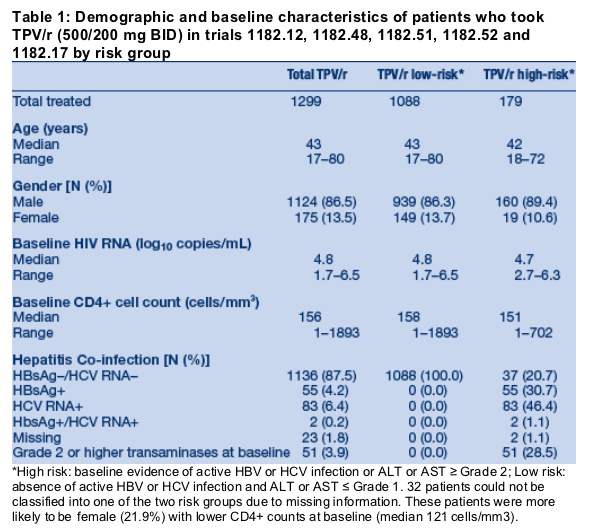
A total of 144 (11.1%) patients had developed Grade 3 or 4 ALT/AST elevations by Week 96; 85% (123/144) of these cases were asymptomatic, i.e. not associated with any clinical adverse events such as fever, malaise, abdominal pain, etc. Twenty one (21; 1.6%) patients who took 500/200 mg BID TPV/r over a period of 96 weeks developed Grade 3 or 4 ALT/AST elevations accompanied by non-serious or serious symptomatic hepatic AEs; only four of these patients
(0.3%) experienced a hepatic SAE.
The K-M risk of developing a Grade 3 or 4 ALT and/or AST level was greatest in the first 24 weeks (6.1%) versus subsequent 24 week periods (Week 48: 9.5%; Week 96: 13.7%) (Table 2).
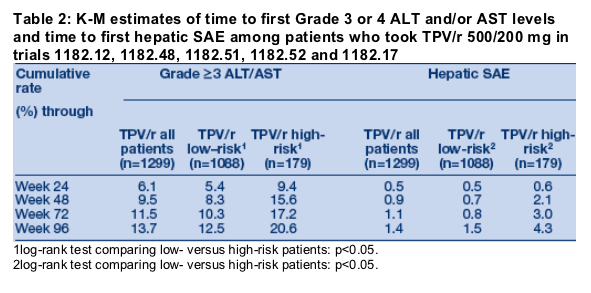
By Week 96, the cumulative risk for Grade 3 or 4 ALT/AST elevations was approximately two fold lower in low-risk (12.5%; 110/1088) patients versus high-risk (20.6%; 30/179) (Figure 1).
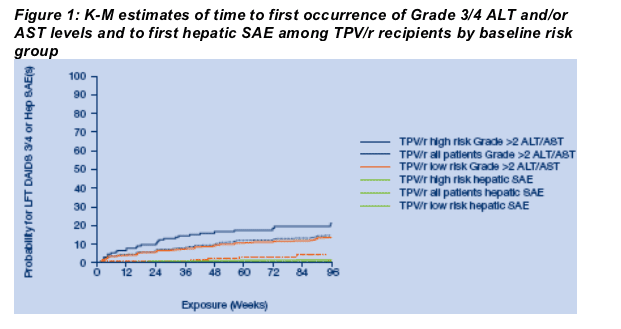
Investigators decided to continue or temporarily interrupt TPV/r in 121/144 patients with ALT/AST Grade 3/4 elevations. The majority (105/144; 72.9%) of these patients were successfully treated with TPV/r with a subsequent decrease in transaminase elevations to Grade ≦2. After developing Grade 3 or 4 ALT/AST levels, 93 patients (93/144; 65%) continued TPV/r treatment. Of these, 88 (94.6%) experienced a return to Grade ≦2 ALT/AST levels in a median of 32 days (IQR=14-84 days) while taking TPV/r. Twenty eight patients (28/144; 19.4%) interrupted therapy at least once. In 17 patients (17/28; 60.7%) who interrupted therapy, elevated transaminase levels returned to Grade ≦2 after a median of 46 days (IQR=20-58 days). However, 11/28 (39.3%) patients who had a treatment interruption developed subsequent recurrence(s) of Grade 3 or 4 transaminases that led to therapy discontinuation.
The course of action taken among low- and high-risk TPV/r patients was similar, with the majority (74% of low risk patients; 81/110 and 73% of high risk patients; 22/30) of patients able to continue, or interrupt and re-introduce, TPV/r treatment. All low-risk patients that continued with TPV/r treatment had transaminase levels return to Grade ≦2 after a median of 29 days. Similarly, among high-risk patients who continued with TPV/r treatment, all patients except one had transaminase levels decrease to Grade ≦2 although the recovery median time was longer
than in low-risk patients (43 days).
Among the 1299 treatment-experienced TPV/r patients, 14 (1.1%) patients experienced hepatic (non-biliary and non-laboratory) SAEs (Figure 2).
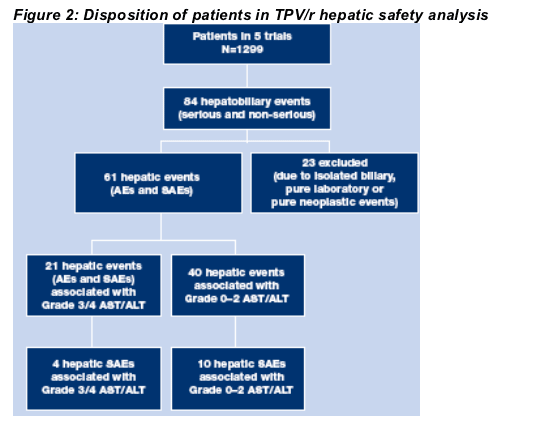
The cumulative risk of clinical hepatic SAEs remained low through 96 weeks (0.5% at week 24, 0.9% at week 48, and 1.4% at week 96) (Table 2 and Figure 1). Among low-risk and high-risk patients, the cumulative risks of hepatic SAEs were similar during the first 24 weeks (0.5% and 0.6%, respectively). However after week 24 the risks of clinical hepatic SAEs increased disproportionately among high-risk patients compared to low-risk patients. High-risk patients,
K-M rates increased to 2.1% at week 48 (an accumulation of 1.5% additional risk from week 24 to week 48), to 3.0% at week 72 (accumulated additional risk of 0.9% from week 48 to 72), and to 4.3% at week 96 (accumulated additional risk of 1.3% from week 72 to 96). For low risk patients, the corresponding accumulation of additional risk was 0.2% from week 24 to week 48, 0.1% from week 48 to 72, and by 0.2% from week 72 to 96.
For all grades of maximal on-treatment ALT/AST, i.e. Grades 0-4, among the high-risk patients there were 5/179 patients (2.8%) with hepatic SAEs: 1 with hepatic failure, 1 with hepatic steatosis, 1 with cirrhosis and liver damage, 1 with hyperbilirubinemia and 1 with hepatic insufficiency and portal hypertension. All five were co-infected with HBV or HCV. There were 9/1088 low-risk patients (0.8%) with hepatic SAEs: 4 with hepatic failure, 2 with steatosis or cirrhosis, and 2 with hepatotoxicity or toxic hepatitis, and one patient with hepatosplenomegaly.
Overall, there were six patients who had a hepatic SAE denoting hepatic failure. Five had fatal outcomes. These events occurred in advanced patients with intercurrent end-stage AIDS events, including disseminated MAI, visceral leshmaniasis, Burkitt's lymphoma, squamous carcinoma, sepsis and multi-organ failure. The sixth patient recovered rapidly and was discharged from the hospital after 5 days.
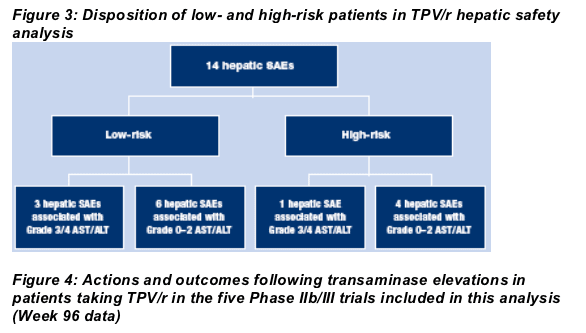
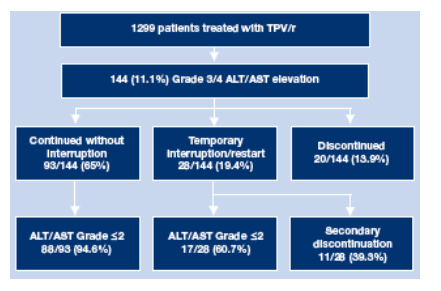
References
1. Hicks CB, et al. Lancet 2006; 368(9534): 466-75.
2. Farthing C, et al. In 46th Interscience Conference on Antimicrobial Agents and Chemotherapy (ICAAC). 2006. San Francisco. Abs. H-1385.
3. Gazzard B, et al. In 8th International Congress on Drug Therapy in HIV Infection. 2006. Glasgow, UK. Abs. P23.
4. Becker S. Clin Infect Dis 2004; 38: S49-55.
5. Kaplowitz N. Clin Infect Dis 2004; 38 Suppl 2: S44-8.
6. Sulkowski MS. Semin Liver Dis 2003; 23(2): 183-94.
7. Sulkowski MS, et al. JAMA, 2000; 283(1): 74-80.
8. Department of Health and Human Services (DHHS) and Henry J. Kaiser Family Foundation. Guidelines for the Use of Antiretroviral Agents in HIV-Infected Adults and Adolescents. 2006 October: Available from: http://www.hivatis.org.
9. Crum NF, et al. J Acquir Immune Defic Syndr 2006; 41(2): 194-200.
10. Sulkowski MS, et al. Aids, 2004. 18(17): 2277-84.
11. Sulkowski M, et al. In 44th Interscience Conference on Antimicrobial Agents and Chemotherapy (ICAAC). 2006. San Francisco. Abs. H-1899
|
| |
|
 |
 |
|
|